Atlantis
Spielvorbereitung
Mit /join können 2-4 Spieler in das Spiel einsteigen. Mit /start beginnt das Spiel. Alternativ dazu kann man die Spielverwaltung benutzen.
Das Spiel
Atlantis ist ein taktisches Laufspiel, bei dem es darum geht, seine Pöppel von der untergehenden Insel aufs rettende Festland zu bringen und dabei noch möglichst viele Punkte zu sammeln. Durch den immer weiter im Wasser versinkenden Weg wird das Laufen jedoch immer teurer, so dass man seine Karten geschickt einsetzen muss, um möglichst günstig weite Strecken zurücklegen zu können.
Für Spieler, die die Regeln bereits beherrschen, gibt es auch eine Kurzanleitung, in der nur noch die Onlinebedienung erklärt wird.
Spielfeld
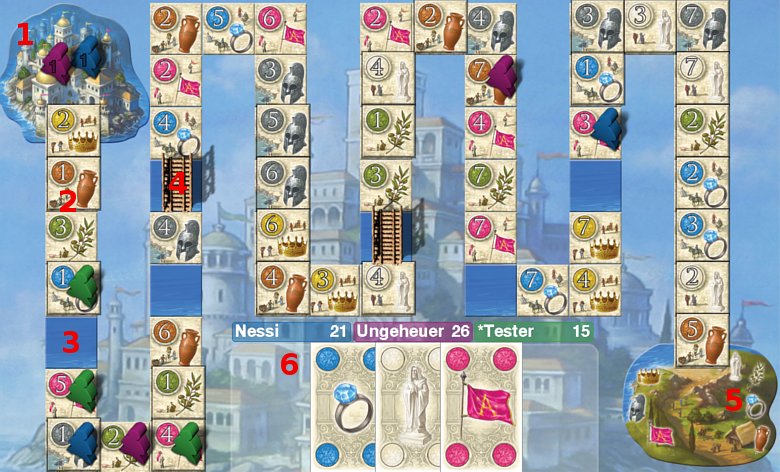
- Startfeld Atlantis
- Wegeplättchen mit Werten von 1-7
- Wasserlücke
- Brücke
- Zielfeld Festland
- Spieleranzeige
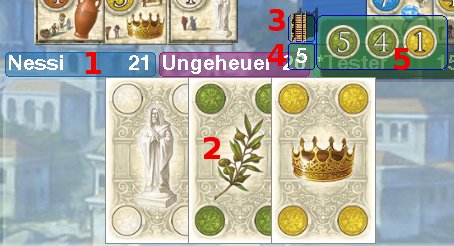
- Spielername und aktuelle Punktzahl
- Eigene Handkarten
- Brückenanzeige (ob schon gebaut oder nicht)
- Handkartenzahl
- gesammelte Punkteplättchen
Vor Spielbeginn
Zu Beginn des Spiels wird der Weg von Atlantis zum Festland (automatisch) ausgelegt. Dabei gilt folgende Reihenfolge: Zehn Zweierstapel, zehn Einzelplättchen, sechs Zweierstapel, dann eine Wasserlücken und daran anschließend wieder sechs Zweierstapel, zehn Einzelplättchen und zehn Zweierstapel.
Jeder Spieler erhält drei Spielfiguren und eine Brücke. Der Startspieler erhält vier Bewegungskarten, der nachfolgende Spieler fünf, usw.
Spielablauf
Jeder Spieler führt nacheinander folgende Aktionen aus:
- Figur bewegen
- Wegeplättchen nehmen
- Eine Bewegungskarte nachziehen
Figur bewegen
Bewegt wird eine Figur, indem man Bewegungskarten aus der Hand spielt. Die Figur rückt entsprechend dem Symbol bzw. der Farbe der Karte auf dem Weg zum nächsten Feld mit dem gleichen Symbol bzw. der gleichen Farbe vor. Ist das nächstliegende Feld mit dieser Farbe besetzt, muss man eine weitere Karte ausspielen und zu dieser Farbe vorhüpfen. Auf einem Feld dürfen nie mehrere Figuren stehen! Mit entsprechend vielen Karten kann man auf diese Weise weite Strecken zurücklegen.
Zum Bewegen einer Figur muss der aktive Spieler als erstes eine Figur, die er bewegen möchte, auswählen. Dazu klickt man einfach auf eine seiner Figuren. Dann werden für diese Figur die möglichen Ziele, die man mit Hilfe seiner Bewegungskarten erreichen kann, angezeigt.
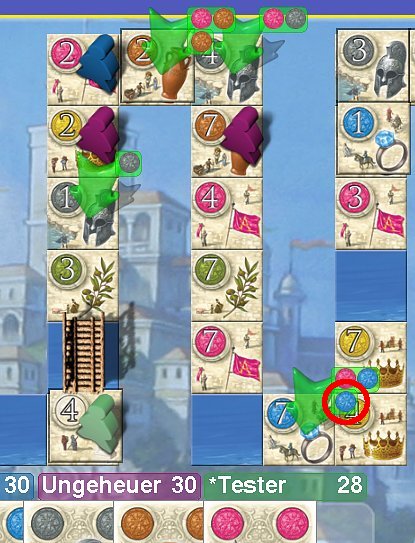
Beispiel: Spieler Grün hat seine Figur unten links angewählt. Er hat je eine Handkarte Blau, Grau, Braun und Rosa. Die grünen Pfeile zeigen ihm nun an, auf welchen Feldern er seinen Zug beenden könnte. Rechts neben den grünen Pfeilen wird jeweils angegeben, welche Karten er für diesen Zug braucht. Um auf die graue Eins zu ziehen, braucht er z.B. nur eine graue Karte. Um auf die graue Vier zu gelangen, kann er zuerst die rosafarbene Karte ausspielen. Da die rosa Zwei besetzt ist, muss er dort weiterspielen und kann durch Ausspielen der grauen Karte auf das nächste graue Feld, also die graue Vier. Um auf die braune Zwei oder die blaue Sieben zu kommen, hat er jeweils zwei Möglichkeiten. Er kommt direkt mit nur einer braunen bzw. blauen Karte dorthin oder, wenn er zuerst die rosafarbene Karte ausspielt, gelangt er auch mit zwei Karten an sein Ziel. Um das gewünschte Ziel auszuwählen, klickt man einfach auf den entsprechenden Farbpunkt neben dem grünen Pfeil. Wollte Grün hier also mit nur einer blauen Karte auf die blaue Sieben springen, müsste er den rot eingekreisten Punkt anklicken.
Wasserlücken
Befinden sich Wasserlücken auf dem Weg, gibt es zwei Möglichkeiten, diese zu überqueren:
- Brücke bauen
- Boot mieten
Die billigste Möglichkeit, eine Wasserlücke zu überqueren, ist, eine Brücke über die Lücke zu bauen. Allerdings hat jeder Spieler nur genau eine Brücke zur Verfügung. Um eine Brücke zu bauen, klickt man auf das gewünschte Wasserfeld.

Zum Abschluss des Baus klickt man auf das Bestätigungsfeld.
Ein Brücke reicht auch über mehrere, zusammenhängende Wasserfelder. Wird ein angrenzendes Wegeplättchen entfernt, wird die Brücke automatisch entsprechend verlängert. Eine gebaute Brücke gilt als kostenloser Übergang für alle Spieler.
Hat man keine Brücke mehr zu Verfügung oder möchte noch nicht bauen, kann man die Wasserlücken auch per Boot überqueren. Dies ist allerdings nicht kostenlos. Der Preis für eine Überquerung richtet sich nach den an die Wasserlücken angrenzenden Wegeplättchen. Der kleinere Wert ist dabei ausschlaggebend und kann mit gesammelten Wegeplättchen oder Handkarten bezahlt werden. Überquert man in einem Zug mehrere Lücken, wird die Anzahl addiert und kann gesammelt gezahlt werden.
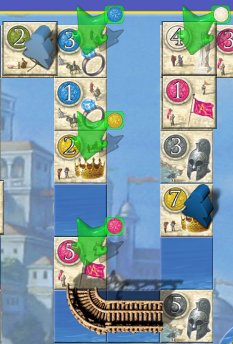
Beispiel: Blau möchte hier durch Ausspielen einer weißen Karte auf die weiße Vier springen. Dazu muss er drei Wasserlücken überqueren. Die erste Lücke wird von einer Zwei und einer Fünf begrenzt, also muss er dafür zwei Punkte zahlen. Die nächste Lücke wird bereits von einer Brücke überspannt, der Übergang ist also kostenlos. Die dritte Lücke wird jedoch von einer Fünf und einer Sieben flankiert und würde also fünf Punkte kosten. Für den kompletten Zug bis zur weißen Vier müsste Blau hier also 2 + 5 = 7 Punkte zahlen.
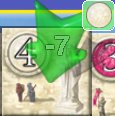
Wieviel man für einen Weg mit Wasserlücken zahlen muss, wird einem angezeigt, wenn man mit der Maus über den entsprechenden grünen Zielpfeil fährt.

Hat man seinen Zug ausgewählt und einen Farbpunkt angeklickt, öffnet sich dieses Fenster, sofern man dabei eine Wasserlücke überqueren muss. Damit wird dargestellt, wieviel Wegezoll zu entrichten ist. Bezahlt werden kann sowohl mit gesammelten Wegeplättchen und/oder mit Handkarten (die Farbe spielt dabei keine Rolle).
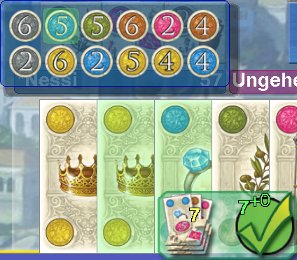
Dazu fährt man mit der Maus über seinen Namen und wählt dort entsprechende Punkte aus und/oder klickt welche der Handkarten an. Hat man den gewünschten Betrag zusammengeklickt, bestätigt man mit dem grünen Haken.
Achtung: Man kann auch (gezwungenermaßen oder unabsichtlich) überzahlen! Muss man z.B. nur Eins zahlen, hat aber nur höhere Punkteplättchen und keine Handkarten mehr, muss man überzahlen! Sprich, man muss dann ein höherwertiges Plättchen abgeben und wertvolle Punkte verschenken. Passt man beim Anwählen nicht auf und wählt nochmal um, sollte man auch immer darauf achten, welche Zahl bei dem grünen Häkchen angezeigt wird, um unabsichtliches Überzahlen zu vermeiden.
Da der Spieler hier kein Siebenerplättchen gesammelt hat, muss er mischen: Er wählt das blaue Fünferplättchen und noch zwei seiner Handkarten dazu.

Sonderfall: Kann ein Spieler mit seinen Handkarten keinen gültigen Zug machen, muss er für diese Runde aussetzen. Als Entschädigung erhält er dafür zwei Handkarten.
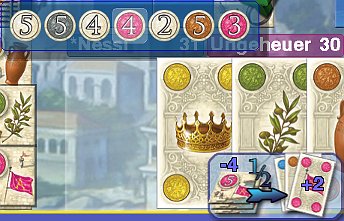
Am Anfang seines Zuges kann ein Spieler durch Abgabe eines Punkteplättchens Bewegungskarten kaufen. Dazu fährt er zu Beginn seines Zuges mit der Maus über seinen Namen, um die Punkteplättchen aufzurufen. Dann kann er ein Plättchen auswählen und erhält die Hälfte des Wertes (bei ungeraden Zahlen wird abgerundet) in Handkarten.
Wegeplättchen nehmen
Hat der Spieler eine Figur gezogen, darf er sich danach noch das nächste freie Wegeplättchen nehmen, das hinter ihm liegt. Befindet sich hinter ihm eine Wasserlücke oder Brücke, gilt das nächstfolgende Plättchen dahinter.
Bewegungskarte nachziehen
Am Ende seines Zuges zieht der Spieler eine Bewegungskarte nach. Sobald man eine Figur auf das Festland gezogen hat, darf man nach jedem Zug zwei Karten nachziehen, bei zwei Figuren auf dem Festland dann immer drei Karten.
Spielende
Das Spiel endet sofort, sobald ein Spieler seine dritte Figur auf das Festland zieht. Er bekommt dafür einmalig noch vier Karten. Die noch verbleibenden Figuren der anderen Spieler werden automatisch aufs Festland gezogen. Die Punkte für eventuelle Wasserüberquerungen werden dabei automatisch vom Punktekonto der Spieler abgezogen. Die Siegpunktezahl errechnet sich aus dem Wert der gesammelten Wegeplättchen plus der übrigen Handkarten (ein Punkt pro Karte). Der Spieler mit den meisten Punkten gewinnt das Spiel. Bei Gleichstand gibt es mehrere Sieger.

